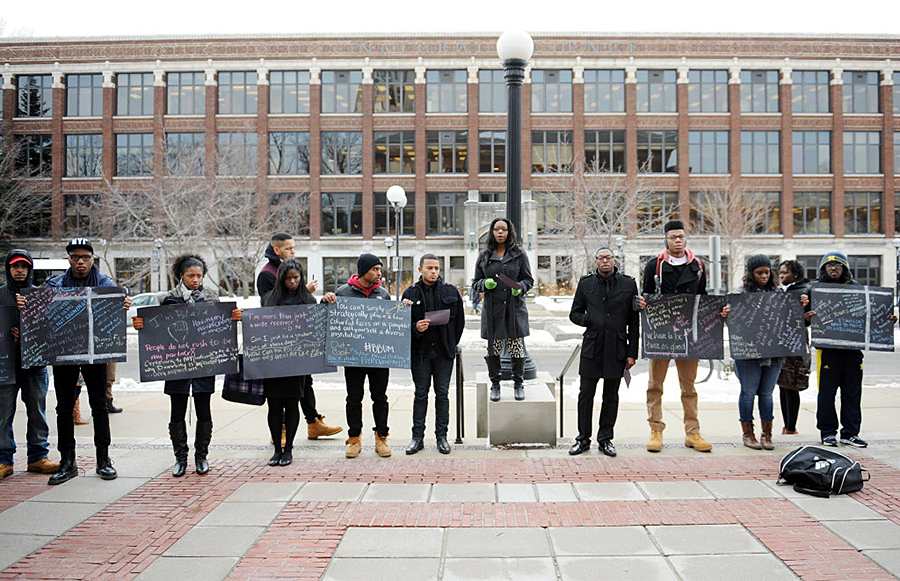Will the University of Michigan's new diversity programs work?
Loading...
The University of Michigan will invest $85 million over the next five years to increase diversity among its students and staff, the school's president announced two days after hundreds of its staff attended a rally against a series of racially-charged fliers discovered on the campus in Ann Arbor.
The programs are part of a five-year strategic plan President Mark Schlissel unveiled at a summit Thursday. They include a program for incoming freshmen with diverse cultural backgrounds and other differences, a training program on inclusiveness for all new faculty, and more outreach programs to increase and maintain diversity among students and staff, according to the Detroit Free Press. The university has already started two enrichment and scholarship programs within the past year for high-achieving African-American students and students from low-income families, said Dr. Schlissel.
The announcement comes after the university’s months-long, multifaceted approach to improving diversity on campus in the wake of protests that include the online campaign the Black Student Union organized in 2013, “Being Black at the University of Michigan,” or #BBUM. Yet, Michigan is far from the only institution to face claims that it lacks diversity.
From the University of Missouri to Yale to Washington University, colleges have been roiled in student demands to increase diversity. But with its plan, Michigan has joined a list of elite institutions that have turned protests into action, says William Smith, executive director of the National Center for Race Amity at Wheelock College in Massachusetts.
“It’s easy to give the verbal salute to ideas. It’s another to commit resources to address it,” Dr. Smith tells The Christian Science Monitor in a phone interview Thursday. “This was a studied approach that should be commended.”
In addition to the university-wide strategic plan, each of the 49 individual schools, colleges, and academic units and departments on the Michigan campus will release its own plans, according to the Detroit Free Press.
At the summit, Schlissel also publicized the two pilot programs the university started within the past year, Wolverine Pathways and HAIL (High Achieving Involved Leaders) scholarships. Wolverine Pathways is a program that aims to act as a pipeline for students from the urban communities of Ypsilanti and Southfield to the University of Michigan. Students from the program accepted to the university will receive a scholarship valued at $60,000. The program will be expanded to Detroit in fall 2017. The HAIL program has the same goals for students from low-income families.
Of the about 43,000 students at the University of Michigan, 4.1 percent are black, 4.1 are Hispanic, and 59.2 percent are white, according to the Chronicle for Higher Education.
Michigan is just one of a number of colleges and universities that have launched new initiatives in response to jarring student protests over racism in recent years.
“Students are demanding more than just an increase in the number of minorities in classrooms. They are searching for a sense of belonging that often goes beyond what the civil rights movement fought for a generation ago,” Harry Bruinius and Jessica Mendoza reported for The Christian Science Monitor.
At Michigan, this frustration was captured in the hashtag, #BBUM. In 2013, the African-American students took to Twitter and social media to draw attention to their concerns about the diversity of the school, including the declining enrollment of African-Americans, according to The New York Times. The Black Student Union began the social media campaign, “Being Black at the University of Michigan,” or #BBUM. The student union encouraged black students to share their positive and negative experiences on campus. The hashtag eventually trended nationally.
Around the same time, about 1,000 protesters expressed frustration over what they said was departing President Mary Sue Coleman’s lack of an adequate response. Campus leaders across the country have faced similar criticism from students and experts.
Scholars who study diversity in education say colleges continue to make the same mistakes, writes the Chronicle for Higher Education’s Beth McMurtie.
From the civil-rights protests of the 1960s to the debates on affirmative action of the 1990s to the broadening of diversity to include sexual orientation and gender identity, colleges have often been reactive, not proactive, experts say. Planning is assigned to ad hoc committees, strategies are designed by small groups of people, and results are expected of those who often lack the authority and resources to produce them. Meanwhile, most people on campuses are left out of the conversation.
But Michigan also joined the ranks of numerous other colleges that have successfully started to implement change, including the University of North Carolina and Florida State University, as well as the University of Washington and Towson University. At Michigan, Schlissel made diversity a key issue of his tenure when he took over for Dr. Coleman in 2014.
As Rob Sellers, whom Schlissel named that day the university's first chief diversity officer, said: "We are not where we want to be, but we are working to become more diverse."







